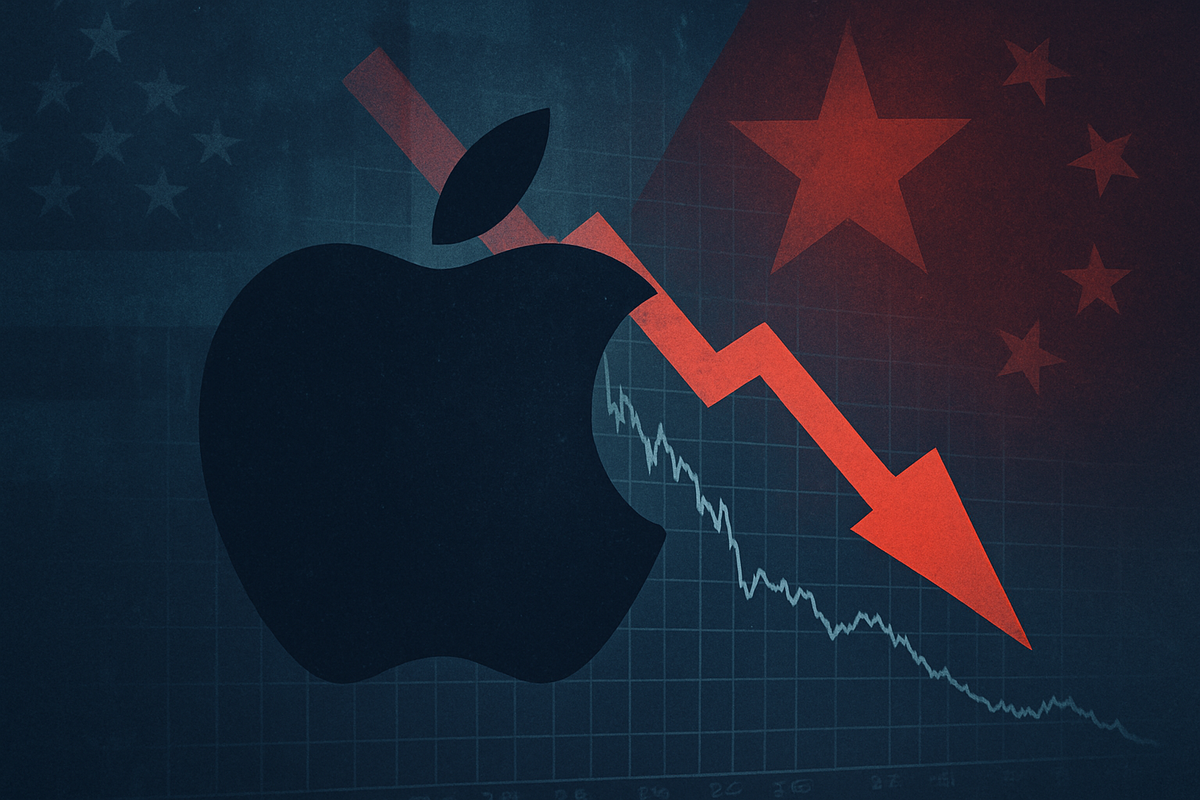
Cupertino tech giant Apple (NASDAQ: AAPL) found itself navigating choppy waters on October 14, 2025, as its stock initially sagged amidst a broader market downturn, heavily influenced by a renewed escalation of trade tensions between the United States and China. While the overall market showed signs of recovery later in the day, Apple's early vulnerability underscored the profound impact of geopolitical friction on its operations and investor sentiment. The immediate implications point to potential increases in production costs and a looming threat to its crucial Chinese market presence.
Geopolitical Headwinds Batter Tech Sector, Apple Feels the Brunt
The trading day on October 14, 2025, commenced with a palpable sense of unease across US markets. Futures for the Dow Jones Industrial Average, S&P 500, and Nasdaq all pointed to a lower open, with the S&P 500 falling 0.5% and the Nasdaq composite shedding 0.9% in early trading. The technology sector, intrinsically linked to global supply chains and international markets, was particularly susceptible to these trade-related jitters, with major tech stocks generally declining. Apple, a bellwether for the sector, experienced weakness in premarket trading and contributed to the initial market slide, cementing its position as a "bottom mover" during the early hours.
This market apprehension was a direct consequence of a re-escalation in the US-China trade dispute. On the preceding Friday, October 10, US President Donald Trump announced intentions to impose "massive" new tariffs on Chinese goods, including a 100% tariff on all imports from China effective November 1, alongside new export controls on "critical software." These aggressive measures were a direct response to China's earlier restrictions on rare earth elements, which are vital for numerous high-tech industries. China swiftly retaliated, announcing new port fees on US-owned, operated, or flagged vessels, effective October 14, and sanctioned five US-associated subsidiaries of a South Korean shipbuilder. Furthermore, China's Ministry of Commerce unveiled sweeping new export restrictions on various rare earths and related technologies. Although rhetoric softened over the weekend, with both nations expressing openness to a deal, the implementation of these "tit-for-tat" measures on October 14 reignited market concerns and triggered the initial downturn.
Despite the early market jitters, US stocks managed to pare some losses by the afternoon of October 14. The S&P 500 recovered to be up about 0.3%, and the Dow Jones surged over 340 points, with the Nasdaq also cutting its losses. This turnaround was influenced by dovish statements from Federal Reserve Chair Jerome Powell and renewed signals that President Trump still intended to meet with President Xi Jinping. However, Apple's year-to-date performance, which saw its shares edge down 2% as of October 14, underperformed other tech giants like Microsoft (NASDAQ: MSFT) and Alphabet (NASDAQ: GOOGL), suggesting that trade tensions, coupled with other factors such as the intensifying race in AI development, remain a significant overhang on the stock. On the preceding Friday, October 10, Apple's shares had fallen sharply by 3.5%, closing at $245.27, directly amidst these renewed threats of a trade war.
Apple and Tech Giants Brace for Impact
The escalating trade tensions pose a significant threat to companies deeply integrated into the global supply chain, with Apple (NASDAQ: AAPL) being particularly exposed. Its extensive manufacturing operations in China and its substantial consumer market presence in the country make it highly vulnerable to both tariffs and retaliatory measures. The immediate impact on Apple includes the potential for increased production costs if new tariffs are imposed on Chinese-made goods. Products like iPhones, iPads, and MacBooks, largely assembled in China, would directly see their manufacturing expenses rise. This could force Apple to either absorb these costs, leading to reduced profit margins, or pass them on to consumers through higher prices, potentially dampening demand in key markets. Analysts project tariffs could negatively impact Apple's gross margin by an estimated $1.1 billion in the fourth quarter of fiscal 2025 alone.
Beyond direct tariff costs, Apple's sales in the crucial Chinese consumer market are at risk. A substantial portion of Apple's revenue is derived from China, and any retaliatory measures by the Chinese government, or a shift in consumer sentiment due to nationalist pressures, could severely affect its sales growth in the region. The recent launch of its iPhone 17 line and the upcoming preorders for the superthin iPhone Air in China starting October 17 highlight Apple's continued commitment to this market, yet also underscore its exposure. Other tech companies with significant manufacturing or sales exposure to China, such as HP Inc. (NYSE: HPQ) and Dell Technologies (NYSE: DELL), could face similar challenges, albeit perhaps not to the same magnitude as Apple's unique market penetration.
Conversely, companies with less reliance on Chinese manufacturing or a more diversified supply chain might find themselves in a relatively stronger position. Furthermore, domestic manufacturers or companies that can quickly pivot their production away from China could potentially gain a competitive advantage. However, given the intricate and deeply entrenched nature of global supply chains in the tech industry, a complete decoupling is a monumental and costly endeavor, making it difficult for many to escape the ripple effects of a full-blown trade war. Semiconductor companies, like Qualcomm (NASDAQ: QCOM) and Broadcom (NASDAQ: AVGO), which supply components to Apple and other manufacturers, could also face indirect impacts through reduced demand or disrupted supply chains.
Broader Implications and Historical Parallels
The current trade skirmish between the US and China is not an isolated incident but rather fits into a broader trend of increasing geopolitical fragmentation and economic nationalism. This event highlights the growing risks associated with globalized supply chains, especially for industries like technology that rely heavily on international cooperation and free trade. The potential for ripple effects extends far beyond direct tariffs, encompassing disruptions to logistics, increased regulatory hurdles, and a chilling effect on foreign investment. Companies may be compelled to accelerate their diversification strategies, exploring manufacturing hubs outside of China in countries like Vietnam, India, or Mexico, a process that is both expensive and time-consuming.
Regulatory and policy implications are significant. The US government's renewed focus on export controls on "critical software" suggests an intent to limit China's access to advanced technologies, potentially impacting a wide range of American tech companies. China's retaliatory measures, such as restrictions on rare earths and new port fees, demonstrate its capacity to inflict economic pain in strategic areas. This tit-for-tat dynamic creates an unpredictable environment, making long-term strategic planning for multinational corporations exceptionally challenging. Historically, trade wars have rarely produced clear winners, often leading to higher costs for consumers, reduced economic growth, and increased market volatility. The US-China trade war of 2018-2019 serves as a stark precedent, demonstrating how tariffs can disrupt supply chains, depress corporate earnings, and weigh on global economic sentiment, without fundamentally altering trade imbalances in the long run.
The current situation also underscores the delicate balance between national security concerns and economic interdependence. Governments are increasingly prioritizing strategic autonomy, which can come at the expense of economic efficiency. This shift could lead to a more regionalized global economy, where companies operate within blocs rather than a truly globalized market. For the tech industry, this could mean a bifurcation of technology standards and ecosystems, potentially forcing companies like Apple to develop different product lines or operating strategies for different markets, adding layers of complexity and cost.
Navigating the Uncertain Path Ahead
In the short term, market volatility is likely to persist as investors react to every development in the US-China trade narrative. Apple (NASDAQ: AAPL) will be under intense scrutiny, with every announcement regarding tariffs or trade talks having the potential to sway its stock price. The immediate focus will be on how Apple manages its supply chain in the face of potential disruptions and increased costs. Strategic pivots may include accelerating efforts to diversify manufacturing outside of China, a process that is already underway but could gain new urgency. This might involve significant capital expenditure and a re-evaluation of existing operational structures.
Looking further ahead, the long-term possibilities for Apple involve a continued balancing act between its reliance on China and the imperative to de-risk its global operations. Should trade tensions escalate further, Apple might be forced to make more drastic decisions regarding its manufacturing footprint and market strategy. This could open up opportunities for other nations to attract significant tech investment, potentially fostering new manufacturing hubs. However, it also presents challenges in maintaining product quality, efficiency, and cost-effectiveness across a more distributed supply chain. The company's ability to innovate and maintain strong consumer loyalty, even in the face of potential price increases or supply chain adjustments, will be critical.
Potential scenarios range from a negotiated de-escalation, which would provide a much-needed reprieve for global markets and companies like Apple, to a prolonged trade conflict that forces a significant restructuring of global commerce. A "cold tech war" scenario, where technological decoupling becomes more pronounced, could lead to two distinct tech ecosystems, one centered around the US and another around China. In such an environment, Apple would face immense pressure to choose sides or adapt its products for fundamentally different regulatory and market landscapes. Investors should watch for any concrete steps Apple takes to diversify its supply chain, its performance in the crucial holiday shopping season, and any shifts in consumer sentiment in its key markets.
A Precarious Balance for Global Tech
The events of October 14, 2025, serve as a potent reminder of the interconnectedness of global financial markets and the profound influence of geopolitical dynamics on corporate valuations. Apple (NASDAQ: AAPL), a titan of industry, finds itself at a precarious juncture, caught between the imperative of maintaining efficient global operations and the pressures of escalating trade tensions. The initial dip in its stock, alongside broader market declines, underscored the immediate investor apprehension regarding the potential for increased production costs, disrupted supply chains, and dampened demand in its critical Chinese market.
Moving forward, the market will remain highly sensitive to any developments in US-China trade relations. While the immediate market recovery on October 14 offered a glimmer of hope, the underlying structural issues and the "tit-for-tat" nature of recent actions suggest that volatility will likely be a recurring theme. The lasting impact of this period could be a fundamental reshaping of global supply chains, with companies prioritizing resilience and diversification over pure cost efficiency. This may lead to higher costs for consumers in the long run but could also foster greater economic security for nations.
Investors should closely monitor Apple's strategies for mitigating trade risks, including any announcements regarding manufacturing shifts or new market expansions. The company's ability to innovate and adapt its business model to a potentially less globalized and more fragmented world will be key to its long-term success. Furthermore, broader economic indicators, policy statements from both Washington and Beijing, and the performance of other multinational corporations with significant exposure to US-China trade will provide crucial insights into the evolving landscape. The current environment demands a vigilant and adaptive approach from both corporations and investors alike.
This content is intended for informational purposes only and is not financial advice





